Our group was convened by the World Health Organization (WHO) in October 2020. We have been the designated independent international members of a joint WHO–China team tasked with understanding the origins of SARS-CoV-2. Our report was published this March1. It was meant to be the first step in a process that has stalled. Here we summarize the scientific process so far, and call for action to fast-track the follow-up scientific work required to identify how COVID-19 emerged, which we set out in this article.
The window of opportunity for conducting this crucial inquiry is closing fast: any delay will render some of the studies biologically impossible. Understanding the origins of a devastating pandemic is a global priority, grounded in science.
The mandate
We, all the members of the international expert team, each submitted detailed, confidential statements to the WHO on potential conflicts of interest, including funding, collaborative studies, public statements and other issues around the origins of COVID-19 that could be perceived as conflicts. After the WHO had reviewed these, team members were appointed in their individual capacity, not as representatives of their employers.
So far, our mission has been guided by terms of reference agreed between the WHO and China in 2020, before our involvement1. These terms tasked us with making a detailed reconstruction of the early phase of the pandemic, beginning in Wuhan, China, where the first known cases were reported. Our mandate was to conduct a collaborative study with leading scientists in China to review data they had generated on the basis of initial questions from the WHO. We refined the generic list of questions described in the mandate into a detailed workplan described in the mission report1 (see also Annex A; go.nature.com/3k26jzx).
WHO report into COVID pandemic origins zeroes in on animal markets, not labs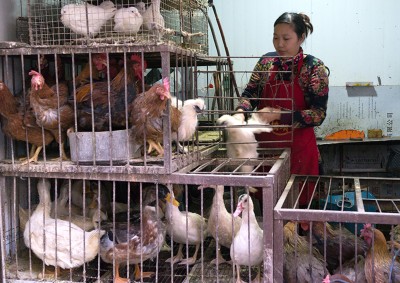
The workplan specified eight items: specific retrospective studies detailing the profile of respiratory illness in the general community and hospitalized people in Wuhan and Hubei in the second half of 2019; a review of patient files for 76,000 cases in the same time period that had been notified by 233 Wuhan health centres; a review of death certificates and analysis of those data for possible clusters; and a detailed reconstruction of the investigation into the early outbreak, combining all data and findings from the various groups involved in human, animal and environmental studies (a One Health approach; see go.nature.com/3jy7ekh). The other four items were: extensive mapping and trace-back of the supply chain of products sold at the Huanan seafood market in Wuhan; testing of a wide range of livestock, wildlife, pets and zoo animals for evidence of infection with SARS-CoV-2; analysis of published and unpublished viral genomic data and linking them with metadata for reconstruction of initial clusters; and a review of relevant literature related to the origins mission.
The possibility of a laboratory origin for the virus’s introduction into the local human population — what has come to be called the lab-leak hypothesis — was not part of the WHO’s original terms of reference for the team.
The mission
This January, we undertook a 28-day mission to Wuhan to interview clinical, laboratory and public-health professionals and visit institutions involved in the early epidemic response and subsequent investigations. Our work was supported by a team of staff from the WHO China office and from WHO headquarters in Geneva, Switzerland; staff from the Food and Agriculture Organization of the United Nations (FAO) and the World Organisation for Animal Health (OIE); and a WHO-appointed team leader1. The huge burden of preparatory work was shouldered by the team in China, including more than 1,000 health-care professionals who collected, analysed, presented and discussed data and study outcomes during our joint mission.
Scientific discussions between the international and Chinese teams during this mission were lively. Large amounts of information were exchanged on the basis of the work carried out. It took days of discussion to develop recommendations on essential further work and ongoing data sharing. We drafted a model of the potential ‘pathways of emergence’ to structure our thoughts. We listed current evidence for and against these pathways (see Fig. 1 of ref. 1).
We found the laboratory origin hypothesis too important to ignore, so brought it into the discussions with our Chinese counterparts. And we included it as one of the hypotheses for SARS-CoV-2 origin in our report.
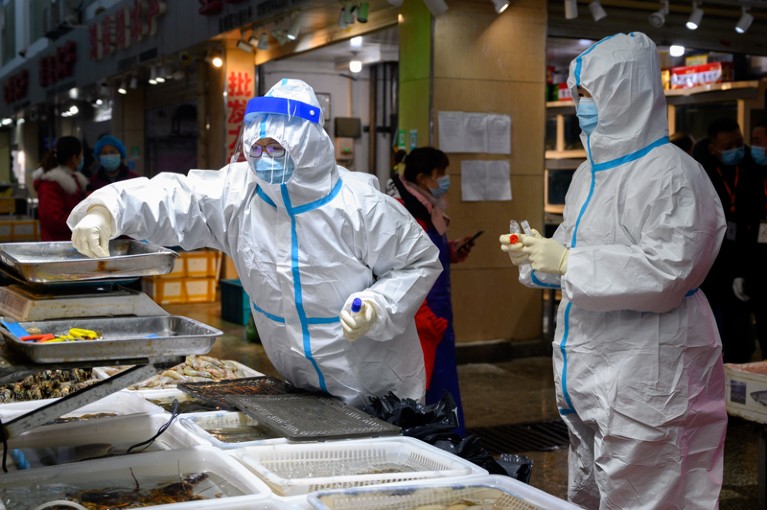
Officials collect COVID-19 test samples in a fresh market in China’s Shanxi province in January.Credit: Wei Liang/China News Service/Getty
We had limited time on the ground in Wuhan and a limited mandate. So we prioritized understanding the role of labs in the early days of the epidemic, the overall lab biosafety procedures and potential staff illness or absenteeism owing to respiratory disease in the late part of 2019. We spoke to the leadership and staff at the three Wuhan labs handling coronaviruses: the Wuhan Institute of Virology, the Chinese Center for Disease Control and Prevention (CDC) in Wuhan, and the Hubei provincial CDC. We reviewed published work from these labs to assess their scientific history of working with coronaviruses related to severe acute respiratory syndrome (SARS).
The Chinese team was and still is reluctant to share raw data (for instance, on the 174 cases identified in December 2019), citing concerns over patient confidentiality. Access to data on these cases was not specified in the mandate, although the WHO had demanded it during the investigation, and has done so since . The legal and possible other barriers could not be addressed in the short time frame of our visit. Also, by then, it was clear that the 174 cases were not likely to be the earliest ones, so we considered them less urgent for understanding origins.
It was therefore agreed that a second phase of studies would address these concerns and review these data.
The report
In our joint report1, members of both teams concluded unanimously that there was clear evidence of widespread SARS-CoV-2 circulation in Wuhan during December 2019. We reported evidence for earlier emergence but reached no resolution on when, where and how that occurred. We concluded that the Huanan seafood market had a significant role in the early part of the pandemic, and that there were credible links to wild-animal markets to follow up. We agreed that the earliest cases of COVID-19 had probably been missed, as is common for outbreaks of new diseases2.
Divisive COVID ‘lab leak’ debate prompts dire warnings from researchers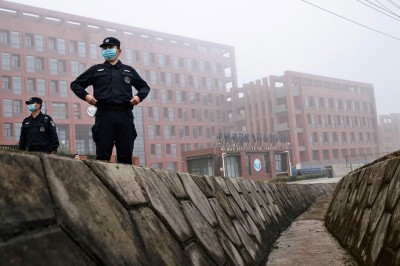
Our joint report summarized the evidence base that was generated during this first phase of origin tracing. It concluded that there was no definitive proof for or against any of the four proposed pathways: direct zoonotic introduction (through a spillover from wild animals) and three indirect routes of introduction (see Fig. 1 of ref. 1 ). These three are: zoonotic infection from handling infected farmed animals; zoonotic introduction through the consumption of contaminated food or food from infected animals; or introduction through escape from a laboratory working with animal viruses. The report noted that we considered direct introduction or indirect zoonotic introduction through an intermediate host the most plausible.
As laid out in our terms of reference, this initial study was not expected to provide definitive answers to the origin of SARS-CoV-2. Rather, phase 1 was always intended to form the foundation of a longer process of scientific investigation that could last for months or years. Therefore, the report put forward recommendations for phase 2 studies that would follow the evidence and trace back further along the most likely pathways. As a joint WHO–China study report, these recommendations were agreed on by members of both the international and the Chinese team. The report also stated that this assessment could be revised if new evidence became available.
The response
Before the report was released, formal statements to the WHO from some governments were circulated in February, with three contentions: that China had not shared data adequately; that we had paid insufficient attention to the lab-leak hypothesis; and that our scientific conclusions were influenced by China’s political stance regarding transmission through the food chain.
Since its release, our report has received extensive coverage in the popular and scientific press and on social media. Much of this has focused on how we conducted the work, and has critiqued us, our methods and results. Five months on, criticisms of the WHO–China joint study continue to emerge.
When asked, our team has emphasized that much new information was shared by the Chinese team as a result of the agreed studies, and that even more was shared as part of the iterative process between the international and Chinese teams.
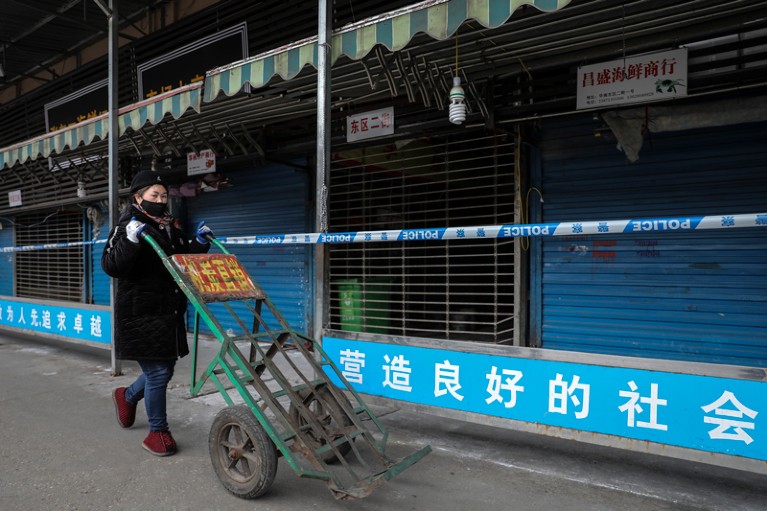
A woman pushes a cart at the closed wholesale seafood market in Wuhan, China, last January.Credit: Getty
Our critics have also suggested that the report dismisses the possibility of a lab leak. A laboratory origin hypothesis is presented in the pathway model in Figure 5 on page 119 of the report; we explicitly state in the report that it is possible. We held frank discussions with key scientists in the relevant Wuhan institutions — a line of inquiry that exceeded our original mandate. When we reviewed the responses to our questions on this issue, and all other available data, we found no evidence for leads to follow up; we reported this fact.
In our report, we state that if evidence supporting any of the hypotheses becomes known following publication, phase 2 studies should carefully examine this. For instance, we described that there was evidence of the presence of live animals in the market at the end of December 2019, but that the data presented to the team did not show definitive evidence of live mammals. This evidence came to light after publication3 (as we discuss in more detail later in this article).
Another criticism was that the potential for introduction of SARS-CoV-2 through frozen food was included owing to pressure from China. The report addressed this hypothesis for three reasons: analysis showed that frozen food imported from all over the world was sold at the Wuhan market, including frozen wild-animal meat; foodborne viral-disease outbreaks are widely documented, including occasionally from frozen foods; and SARS-CoV-2 can remain infectious when frozen4. Therefore, the team felt it could not rule out introduction from undercooked meat from infected animals.
Some of the public discourse around the report probably originates from miscommunication and misunderstanding about the nature of the work. Although the published report correctly calls it a joint study to reflect what was laid out in the World Health Assembly resolution and terms of reference, it was publicly called an investigation by journalists, by representatives from some member states and, on occasion, by representatives of the WHO. This might have led to expectations that the report would provide watertight evidence based on formal audits of the institutes involved in the studies.
New data
There have been calls from scientists for further investigation of the lab-leak hypothesis5. And there has been a wave of media items that give equivalence to the weight of evidence for a lab leak and for emergence through an intermediate host — an equivalence that the currently available data do not support, in our view.
The COVID lab-leak hypothesis: what scientists do and don’t know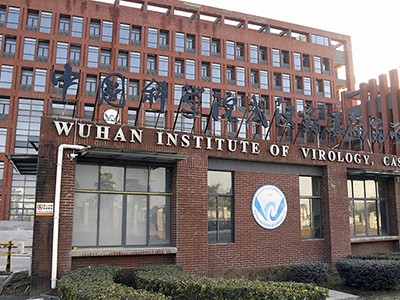
The arguments and data for a zoonotic spillover event were summarized in a review published as a July preprint by a group of scientists who were not part of the international team6. That review includes new data released since the report, on SARS-CoV-2-related coronaviruses in bats in China’s Yunnan province7,8 and an inventory of live mammals for sale in Wuhan markets up until November 2019, some of which could have theoretically been able to harbour SARS-related coronaviruses3. This inventory, compiled by scientists from the United Kingdom, Canada and China, would have been welcomed by the team had it been available earlier; it needs to be taken up in the phase 2 studies.
In June, a preprint9 was published analysing genomic data that had been deleted after March 2020 from the database of the US National Center for Biotechnology Information at the request of the scientists from China who generated the information (that team had published its findings based on the raw data in June 202010). Our colleagues in China contacted the authors of the June 2020 paper, retrieved the data and added them to the SARS-CoV-2 genome phylogenetic data published in our report. The data were from people who had an onset of illness in January, so they did not contribute any new information to the origins question.
In the report, and since, we have publicly called for any data supporting the lab-leak hypothesis to be published and submitted to the WHO. None has, so far.
Six priorities
To keep up the momentum for phase 2 studies, our team has met weekly since the publication of the joint report. We have continued collaboration with our Chinese co-authors, including work on a list of corrections to the phase 1 report. Both the international team and the Chinese team have now put forward to the WHO priorities for phase 2 studies, developed from the recommendations in the joint report.
The international team listed the following priorities:
Further trace-back studies. On the basis of disease reporting, look for early COVID-19 cases in all regions inside and outside China that have the earliest evidence for SARS-CoV-2 circulation.
Antibody surveys. Use standardized methods in the regions that have the earliest evidence for SARS-CoV-2 circulation (inside and outside China) to identify any places where infections occurred that were not observed through disease reporting.
Trace-back and community surveys. These will need to be conducted at sites of wildlife farms that supplied animals to markets in Wuhan in the months before human cases were recognized (inside and outside China, depending on supply-chain analysis).
Risk-targeted surveys of possible hosts. Assess wild bats and other potential reservoirs or intermediate hosts in China and neighbouring countries, and selected high-risk farmed animals (including those farmed for fur), for evidence of exposure.
Detailed risk-factor analysis. Analyse pockets of earlier cases evidenced from the antibody surveys or other studies, and conduct an assessment of all possible exposures.
Follow-up. Investigate any credible new leads.
Time’s up
The search for the origins of SARS-CoV-2 is at a critical juncture. There is willingness to move forward from both the WHO international team and the Chinese team.
Crucially, the window is rapidly closing on the biological feasibility of conducting the critical trace-back of people and animals inside and outside China. SARS-CoV-2 antibodies wane, so collecting further samples and testing people who might have been exposed before December 2019 will yield diminishing returns. Chinese wildlife farms employ millions of people (14 million, according to a 2016 census11) and supplied live mammals to cities across China, including Wuhan3. In response to the SARS-CoV-2 pandemic, many of these farms are now closed and the animals have been culled, making any evidence of early coronavirus spillover increasingly difficult to find.
In July, four months after the full report and five months after our debriefing, the WHO informed member states of plans to create a committee that will oversee future origins studies. We are pleased to see both this and its implication that outbreak investigations will be conducted routinely, rather than in an ad hoc manner that could be perceived as politically motivated or with potentially punitive goals.
However, applying this new process to the continuing SARS-CoV-2 origins mission runs the risk of adding several months of delay. Member-state representatives would need to negotiate detailed terms around the sensitive issue of investigating laboratory practices, then nominate and select team members, who would then have to develop a work plan.
Therefore, we call on the scientific community and country leaders to join forces to expedite the phase 2 studies detailed here, while there is still time.

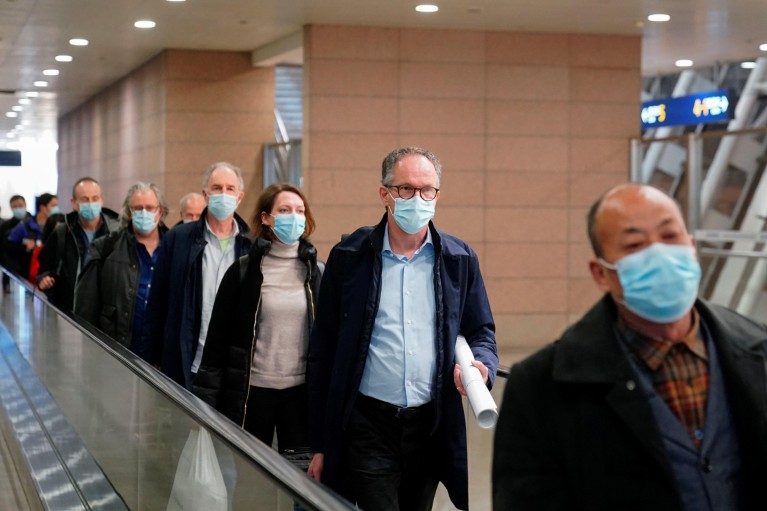
 The COVID lab-leak hypothesis: what scientists do and don’t know
The COVID lab-leak hypothesis: what scientists do and don’t know
 Divisive COVID ‘lab leak’ debate prompts dire warnings from researchers
Divisive COVID ‘lab leak’ debate prompts dire warnings from researchers
 ‘Major stones unturned’: COVID origin search must continue after WHO report, say scientists
‘Major stones unturned’: COVID origin search must continue after WHO report, say scientists
 WHO report into COVID pandemic origins zeroes in on animal markets, not labs
WHO report into COVID pandemic origins zeroes in on animal markets, not labs





